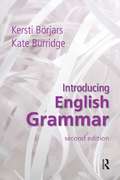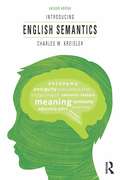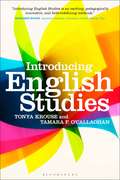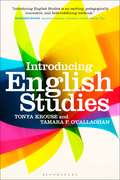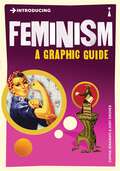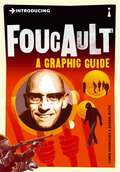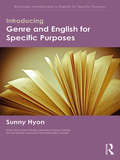- Table View
- List View
Introducing English for Specific Purposes (Routledge Introductions to English for Specific Purposes)
by Laurence AnthonyIntroducing English for Specific Purposes presents the key concepts and practices of ESP in a modern, balanced, and comprehensive way. This book defines ESP and shows how the approach plays a crucial role in the world of English language teaching. Explaining how needs analysis, language and learning objectives, materials and methods, and evaluation combine to form the four main pillars of ESP, the book includes: practical examples that illustrate how the core theories and practices of ESP can be applied in real-world academic and occupational settings; discussion of some of the most hotly debated issues in ESP; insights on how ESP courses can be organized and integrated to form a complete program; reflection boxes, practical tasks, extension research questions, and resources for further reading in each chapter. Introducing English for Specific Purposes serves as an ideal textbook for graduate and advanced undergraduate students studying courses on English for Specific Purposes or English for Academic Purposes, as part of degrees in English for Specific Purposes, Education, ELT, Applied Linguistics, TESOL or TEFL. This comprehensive publication is also an invaluable reference resource for pre-service and in-service teachers of ESP, and for English program managers and administrators.
Introducing English for Specific Purposes (Routledge Introductions to English for Specific Purposes)
by Laurence AnthonyIntroducing English for Specific Purposes presents the key concepts and practices of ESP in a modern, balanced, and comprehensive way. This book defines ESP and shows how the approach plays a crucial role in the world of English language teaching. Explaining how needs analysis, language and learning objectives, materials and methods, and evaluation combine to form the four main pillars of ESP, the book includes: practical examples that illustrate how the core theories and practices of ESP can be applied in real-world academic and occupational settings; discussion of some of the most hotly debated issues in ESP; insights on how ESP courses can be organized and integrated to form a complete program; reflection boxes, practical tasks, extension research questions, and resources for further reading in each chapter. Introducing English for Specific Purposes serves as an ideal textbook for graduate and advanced undergraduate students studying courses on English for Specific Purposes or English for Academic Purposes, as part of degrees in English for Specific Purposes, Education, ELT, Applied Linguistics, TESOL or TEFL. This comprehensive publication is also an invaluable reference resource for pre-service and in-service teachers of ESP, and for English program managers and administrators.
Introducing English Grammar
by Kersti Borjars Kate BurridgeAnswering key questions such as 'Why study grammar?' and 'What is standard English?', Introducing English Grammar guides readers through the practical analysis of the syntax of English sentences. With all special terms carefully explained as they are introduced, the book is written for readers with no previous experience of grammatical analysis. It is ideal for all those beginning their study of linguistics, English language or speech pathology, as well as students with primarily literary interests who need to cover the basics of linguistic analysis.The approach taken is in line with current research in grammar, a particular advantage for students who may go on to study syntax in more depth. All the examples and exercises use real language taken from newspaper articles, non-standard dialects and include excerpts from studies of patients with language difficulties. Students are encouraged to think about the terminology as a tool kit for studying language and to test what can and cannot be described using these tools.This new edition has been fully revised in line with recent research. There is a new chapter on World English, a new glossary and a free website with extensive further reading and answers to the exercises.
Introducing English Grammar
by Kersti Borjars Kate BurridgeAnswering key questions such as 'Why study grammar?' and 'What is standard English?', Introducing English Grammar guides readers through the practical analysis of the syntax of English sentences. With all special terms carefully explained as they are introduced, the book is written for readers with no previous experience of grammatical analysis. It is ideal for all those beginning their study of linguistics, English language or speech pathology, as well as students with primarily literary interests who need to cover the basics of linguistic analysis.The approach taken is in line with current research in grammar, a particular advantage for students who may go on to study syntax in more depth. All the examples and exercises use real language taken from newspaper articles, non-standard dialects and include excerpts from studies of patients with language difficulties. Students are encouraged to think about the terminology as a tool kit for studying language and to test what can and cannot be described using these tools.This new edition has been fully revised in line with recent research. There is a new chapter on World English, a new glossary and a free website with extensive further reading and answers to the exercises.
Introducing English Grammar
by Kersti Börjars Kate BurridgeIntroducing English Grammar introduces readers to the methodology and terminology needed to analyse English sentences. The approach taken is in line with current research in grammar, a particular advantage for students who may go on to study syntax in more depth. All the examples and exercises use real language taken from both standard and non-standard geographical areas and dialects, and include excerpts from Australian and British newspaper articles. Students are encouraged to think about the terminology as a tool kit for studying language and to test what can and cannot be described using these tools. This new edition has been fully updated and features: an expanded introduction; new texts and exercises that include data from social media; revised material on 'Grammar at work' and 'English worldwide'; more suggestions for further reading at the end of the book; a brand new companion website with extensive further reading and answers to the exercises, which can be found at www.routledge.com/cw/borjars. Written for readers with no previous experience of grammatical analysis, Introducing English Grammar is suited to anyone beginning a study of linguistics, English language or speech pathology, as well as to students whose interests are primarily literary but who need a better understanding of the structure of English.
Introducing English Grammar (A\hodder Arnold Publication)
by Kersti Börjars Kate BurridgeIntroducing English Grammar introduces readers to the methodology and terminology needed to analyse English sentences. The approach taken is in line with current research in grammar, a particular advantage for students who may go on to study syntax in more depth. All the examples and exercises use real language taken from both standard and non-standard geographical areas and dialects, and include excerpts from Australian and British newspaper articles. Students are encouraged to think about the terminology as a tool kit for studying language and to test what can and cannot be described using these tools. This new edition has been fully updated and features: an expanded introduction; new texts and exercises that include data from social media; revised material on 'Grammar at work' and 'English worldwide'; more suggestions for further reading at the end of the book; a brand new companion website with extensive further reading and answers to the exercises, which can be found at www.routledge.com/cw/borjars. Written for readers with no previous experience of grammatical analysis, Introducing English Grammar is suited to anyone beginning a study of linguistics, English language or speech pathology, as well as to students whose interests are primarily literary but who need a better understanding of the structure of English.
Introducing English Grammar
by David J. YoungIntroducing English Grammar provides a basic grounding in English grammar, without going into too much detail or theory, and will lay the foundation for further grammatical studies. David Young presents English grammar in a coherent and lively way. He dispels the popular notion among students that grammar is simply a set of dreary rules and argues for the importance of grammar in describing the structure and function of language itself. Exercises are provided at the end of each chapter and the book includes integrated diagrams and a glossary of technical terms at the back of the book.
Introducing English Grammar
by David J. YoungIntroducing English Grammar provides a basic grounding in English grammar, without going into too much detail or theory, and will lay the foundation for further grammatical studies. David Young presents English grammar in a coherent and lively way. He dispels the popular notion among students that grammar is simply a set of dreary rules and argues for the importance of grammar in describing the structure and function of language itself. Exercises are provided at the end of each chapter and the book includes integrated diagrams and a glossary of technical terms at the back of the book.
Introducing English Grammar (PDF)
by Kate Burridge Kersti BörjarsAnswering key questions such as 'Why study grammar?' and 'What is standard English?', Introducing English Grammarguides readers through the practical analysis of the syntax of English sentences. With all special terms carefully explained as they are introduced, the book is written for readers with no previous experience of grammatical analysis. It is ideal for all those beginning their study of linguistics, English language or speech pathology, as well as students with primarily literary interests who need to cover the basics of linguistic analysis. The approach taken is in line with current research in grammar, a particular advantage for students who may go on to study syntax in more depth. All the examples and exercises use real language taken from newspaper articles, non-standard dialects and include excerpts from studies of patients with language difficulties. Students are encouraged to think about the terminology as a tool kit for studying language and to test what can and cannot be described using these tools. This new edition has been fully revised in line with recent research. There is a new chapter on World English, a new glossary and a free website with extensive further reading and answers to the exercises, which can be found at www. routledge. com/cw/borjars
Introducing English Language: A Resource Book For Students (PDF)
by Louise Mullany Peter StockwellRoutledge English Language Introductionscover core areas of language study and are one-stop resources for students. Assuming no prior knowledge, books in the series offer an accessible overview of the subject, with activities, study questions, sample analyses, commentaries and key readings - all in the same volume. The innovative and flexible 'two-dimensional' structure is built around four sections - introduction, development, exploration and extension - which offer self-contained stages for study. Each topic can also be read across these sections, enabling the reader to build gradually on the knowledge gained. Introducing English Language: is the foundational book in the Routledge English Language Introductionsseries, providing an accessible introduction to the English language contains newly expanded coverage of morphology, updated and revised exercises, and an extended Further Reading section comprehensively covers key disciplines of linguistics such as historical linguistics, sociolinguistics and psycholinguistics, as well as core areas in language study including acquisition, standardisation and the globalisation of English uses a wide variety of real texts and images from around the world, including a Monty Python sketch, excerpts from novels such as Virginia Woolf's To the Lighthouse, and news items from Metro and the BBC provides updated classic readings by the key names in the discipline, including Guy Cook, Andy Kirkpatrick and Zoltán Dörnyei is accompanied by a website with extra activities, project ideas for each unit, suggestions for further reading, links to essential English language resources, and course templates for lecturers. Written by two experienced teachers and authors, this accessible textbook is an essential resource for all students of the English language and linguistics.
Introducing English Language: A Resource Book For Students
by Louise Mullany Peter StockwellRoutledge English Language Introductionscover core areas of language study and are one-stop resources for students. Assuming no prior knowledge, books in the series offer an accessible overview of the subject, with activities, study questions, sample analyses, commentaries and key readings - all in the same volume. The innovative and flexible 'two-dimensional' structure is built around four sections - introduction, development, exploration and extension - which offer self-contained stages for study. Each topic can also be read across these sections, enabling the reader to build gradually on the knowledge gained. Introducing English Language: is the foundational book in the Routledge English Language Introductionsseries, providing an accessible introduction to the English language contains newly expanded coverage of morphology, updated and revised exercises, and an extended Further Reading section comprehensively covers key disciplines of linguistics such as historical linguistics, sociolinguistics and psycholinguistics, as well as core areas in language study including acquisition, standardisation and the globalisation of English uses a wide variety of real texts and images from around the world, including a Monty Python sketch, excerpts from novels such as Virginia Woolf's To the Lighthouse, and news items from Metro and the BBC provides updated classic readings by the key names in the discipline, including Guy Cook, Andy Kirkpatrick and Zoltán Dörnyei is accompanied by a website with extra activities, project ideas for each unit, suggestions for further reading, links to essential English language resources, and course templates for lecturers. Written by two experienced teachers and authors, this accessible textbook is an essential resource for all students of the English language and linguistics.
Introducing English Language: A Resource Book for Students (Routledge English Language Introductions)
by Peter Stockwell Louise MullanyRoutledge English Language Introductions cover core areas of language study and are one-stop resources for students. Assuming no prior knowledge, books in the series offer an accessible overview of the subject, with activities, study questions, sample analyses, commentaries and key readings – all in the same volume. The innovative and flexible ‘two-dimensional’ structure is built around four sections – introduction, development, exploration and extension – which offer self-contained stages for study. Each topic can also be read across these sections, enabling the reader to build gradually on the knowledge gained. Introducing English Language: is the foundational book in the Routledge English Language Introductions series, providing an accessible introduction to the English language contains newly expanded coverage of morphology, updated and revised exercises, and an extended Further Reading section comprehensively covers key disciplines of linguistics such as historical linguistics, sociolinguistics and psycholinguistics, as well as core areas in language study including acquisition, standardisation and the globalisation of English uses a wide variety of real texts and images from around the world, including a Monty Python sketch, excerpts from novels such as Virginia Woolf’s To the Lighthouse, and news items from Metro and the BBC provides updated classic readings by the key names in the discipline, including Guy Cook, Andy Kirkpatrick and Zoltán Dörnyei is accompanied by a website with extra activities, project ideas for each unit, suggestions for further reading, links to essential English language resources, and course templates for lecturers. Written by two experienced teachers and authors, this accessible textbook is an essential resource for all students of the English language and linguistics.
Introducing English Language: A Resource Book for Students (Routledge English Language Introductions)
by Peter Stockwell Louise MullanyRoutledge English Language Introductions cover core areas of language study and are one-stop resources for students. Assuming no prior knowledge, books in the series offer an accessible overview of the subject, with activities, study questions, sample analyses, commentaries and key readings – all in the same volume. The innovative and flexible ‘two-dimensional’ structure is built around four sections – introduction, development, exploration and extension – which offer self-contained stages for study. Each topic can also be read across these sections, enabling the reader to build gradually on the knowledge gained. Introducing English Language: is the foundational book in the Routledge English Language Introductions series, providing an accessible introduction to the English language contains newly expanded coverage of morphology, updated and revised exercises, and an extended Further Reading section comprehensively covers key disciplines of linguistics such as historical linguistics, sociolinguistics and psycholinguistics, as well as core areas in language study including acquisition, standardisation and the globalisation of English uses a wide variety of real texts and images from around the world, including a Monty Python sketch, excerpts from novels such as Virginia Woolf’s To the Lighthouse, and news items from Metro and the BBC provides updated classic readings by the key names in the discipline, including Guy Cook, Andy Kirkpatrick and Zoltán Dörnyei is accompanied by a website with extra activities, project ideas for each unit, suggestions for further reading, links to essential English language resources, and course templates for lecturers. Written by two experienced teachers and authors, this accessible textbook is an essential resource for all students of the English language and linguistics.
Introducing English Semantics
by Charles W. KreidlerIntroducing English Semantics, Second Edition is a practical introduction to understanding how meanings are expressed in the English language. Presenting the basic principles of the discipline of semantics, this newly revised edition explores the knowledge of language that speakers have which enables them to communicate - to express observations, opinions, intentions and the products of their imagination. The text emphasises pragmatic investigation with numerous illustrative examples of concepts and ample exercises to help students develop and improve their linguistic analysis skills. Introducing English Semantics: Discusses the nature of human language and how linguists categorise and examine it. Covers meanings expressed in English words, prefixes, suffixes and sentences. Examines such relations as synonymy, antonymy, hyponymy, ambiguity, implication, factivity, aspect, and modality Draws comparisons between English and other languages Illustrates the importance of 'tone of voice' and 'body language' in face-to-face exchanges and the role of context in any communication Contains a wealth of exercises and a glossary to clearly define all terminology This new edition includes expanded and updated textual exercises and a greater focus on compounds and other kinds of composite lexemes. Written in a clear and accessible style, Introducing English Semantics is an essential text for any student taking an introductory course in semantics.
Introducing English Semantics
by Charles W. KreidlerIntroducing English Semantics, Second Edition is a practical introduction to understanding how meanings are expressed in the English language. Presenting the basic principles of the discipline of semantics, this newly revised edition explores the knowledge of language that speakers have which enables them to communicate - to express observations, opinions, intentions and the products of their imagination. The text emphasises pragmatic investigation with numerous illustrative examples of concepts and ample exercises to help students develop and improve their linguistic analysis skills. Introducing English Semantics: Discusses the nature of human language and how linguists categorise and examine it. Covers meanings expressed in English words, prefixes, suffixes and sentences. Examines such relations as synonymy, antonymy, hyponymy, ambiguity, implication, factivity, aspect, and modality Draws comparisons between English and other languages Illustrates the importance of 'tone of voice' and 'body language' in face-to-face exchanges and the role of context in any communication Contains a wealth of exercises and a glossary to clearly define all terminology This new edition includes expanded and updated textual exercises and a greater focus on compounds and other kinds of composite lexemes. Written in a clear and accessible style, Introducing English Semantics is an essential text for any student taking an introductory course in semantics.
Introducing English Studies
by Tonya Krouse Tamara F. O'CallaghanFrom literary studies to digital humanities, Introducing English Studies is a complete introduction to the many fields and sub-disciplines of English studies for majors starting out in the subject for the first time. The book covers topics including:· history of English language and linguistics· literature and literary criticism· cinema and new media Studies· composition and rhetoric· creative and professional writing· critical theory· digital humanitiesThe book is organized around the central questions of the field and includes case studies demonstrating how assignments might be approached, as well as annotated guides to further reading to support more in-depth study. A glossary of key critical terms helps readers locate essential definitions quickly when studying and writing and revising essays. A supporting companion website also offers sample assignments and activities, examples of student writing, career guidance and weblinks.
Introducing English Studies
by Tonya Krouse Tamara F. O'CallaghanFrom literary studies to digital humanities, Introducing English Studies is a complete introduction to the many fields and sub-disciplines of English studies for majors starting out in the subject for the first time. The book covers topics including:· history of English language and linguistics· literature and literary criticism· cinema and new media Studies· composition and rhetoric· creative and professional writing· critical theory· digital humanitiesThe book is organized around the central questions of the field and includes case studies demonstrating how assignments might be approached, as well as annotated guides to further reading to support more in-depth study. A glossary of key critical terms helps readers locate essential definitions quickly when studying and writing and revising essays. A supporting companion website also offers sample assignments and activities, examples of student writing, career guidance and weblinks.
Introducing English Syntax: A Basic Guide for Students of English
by Peter Fenn Götz SchwabIntroducing English Syntax provides a basic introduction to syntax for students studying English as a foreign language at university. Examining English phrase and sentence structure from a descriptive point of view, this book develops the reader’s understanding of the characteristic features of English sentence construction and provides the necessary theoretical apparatus for engaging with the language. Key features include: A unique framework combining theoretical and practical approaches to provide an insight into the intricacies of English syntax; An accessible and clear style which guides the learner through analysis, application and practical construction of sentences; A range of exercises at the end of each chapter and a brand new e-resource housing answers and commentaries to these exercises. This book requires no previous knowledge of linguistics and is essential reading for students and teachers of applied linguistics and EFL/ESL, as well as those who seek a basic grounding in English sentence structure.
Introducing English Syntax: A Basic Guide for Students of English
by Peter Fenn Götz SchwabIntroducing English Syntax provides a basic introduction to syntax for students studying English as a foreign language at university. Examining English phrase and sentence structure from a descriptive point of view, this book develops the reader’s understanding of the characteristic features of English sentence construction and provides the necessary theoretical apparatus for engaging with the language. Key features include: A unique framework combining theoretical and practical approaches to provide an insight into the intricacies of English syntax; An accessible and clear style which guides the learner through analysis, application and practical construction of sentences; A range of exercises at the end of each chapter and a brand new e-resource housing answers and commentaries to these exercises. This book requires no previous knowledge of linguistics and is essential reading for students and teachers of applied linguistics and EFL/ESL, as well as those who seek a basic grounding in English sentence structure.
Introducing Feminism: A Graphic Guide (Introducing...)
by Cathia JenainatiThe term 'feminism' came into English usage around the 1890s, but women's conscious struggle to resist discrimination and sexist oppression goes much further back. This completely new and updated edition of "Introducing Feminism" surveys the major developments that have affected women's lives from the 17th century to the present day. "Introducing Feminism" is an invaluable reference book for anyone seeking the story of how feminism reconfigured the world for women and men alike.
Introducing Foucault: A Graphic Guide (Introducing...)
by Chris HorrocksMichel Foucault's work was described at his death as 'the most important event of thought in our century'. As a philosopher, historian and political activist, he certainly left behind an enduring and influential body of work, but is this acclaim justified? "Introducing Foucault" places his work in its turbulent philosophical and political context, and critically explores his mission to expose the links between knowledge and power in the human sciences, their discourses and institutions. This book explains how Foucault overturned our assumptions about the experience and perception of madness, sexuality and criminality, and the often brutal social practices of confinement, confession and discipline. It also describes Foucault's engagement with psychiatry and clinical medicine, his political activism and the transgressive aspects of pleasure and desire that he promoted in his writing.
Introducing Functional Grammar
by Geoff ThompsonIntroducing Functional Grammar, third edition, provides a user-friendly overview of the theoretical and practical aspects of the systemic functional grammar (SFG) model. No prior knowledge of formal linguistics is required as the book provides: An opening chapter on the purpose of linguistic analysis, which outlines the differences between the two major approaches to grammar - functional and formal. An overview of the SFG model - what it is and how it works. Advice and practice on identifying elements of language structure such as clauses and clause constituents. Numerous examples of text analysis using the categories introduced, and discussion about what the analysis shows. Exercises to test comprehension, along with answers for guidance. The third edition is updated throughout, and is based closely on the fourth edition of Halliday and Matthiessen's Introduction to Functional Grammar. A glossary of terms, more exercises and an additional chapter are available on the product page at: https://www.routledge.com/9781444152678. Introducing Functional Grammar remains the essential entry guide to Hallidayan functional grammar, for undergraduate and postgraduate students of language and linguistics.
Introducing Functional Grammar: Introducing Functional Grammar
by Geoff ThompsonIntroducing Functional Grammar, third edition, provides a user-friendly overview of the theoretical and practical aspects of the systemic functional grammar (SFG) model. No prior knowledge of formal linguistics is required as the book provides: An opening chapter on the purpose of linguistic analysis, which outlines the differences between the two major approaches to grammar - functional and formal. An overview of the SFG model - what it is and how it works. Advice and practice on identifying elements of language structure such as clauses and clause constituents. Numerous examples of text analysis using the categories introduced, and discussion about what the analysis shows. Exercises to test comprehension, along with answers for guidance. The third edition is updated throughout, and is based closely on the fourth edition of Halliday and Matthiessen's Introduction to Functional Grammar. A glossary of terms, more exercises and an additional chapter are available on the product page at: https://www.routledge.com/9781444152678. Introducing Functional Grammar remains the essential entry guide to Hallidayan functional grammar, for undergraduate and postgraduate students of language and linguistics.
Introducing Genre and English for Specific Purposes (Routledge Introductions to English for Specific Purposes)
by Sunny HyonGenre analysis has become a key approach within the field of English for Specific Purposes and helps students understand particular language use patterns in target contexts. Introducing Genre and English for Specific Purposes provides an overview of how genre has been conceptualized and applied in ESP, as well as the features that distinguish ESP genre research and teaching from those of other genre schools. The macro and micro aspects of ESP genre-based pedagogy are also analysed and include: different possibilities for planning and designing an ESP genre-based course; the concrete, micro aspects of materials creation; and how genres can be learned through play. Introducing Genre and English for Specific Purposes is essential reading for students and pre-service teachers who are studying Genre, English for Specific Purposes or language teaching methodologies.
Introducing Genre and English for Specific Purposes (Routledge Introductions to English for Specific Purposes)
by Sunny HyonGenre analysis has become a key approach within the field of English for Specific Purposes and helps students understand particular language use patterns in target contexts. Introducing Genre and English for Specific Purposes provides an overview of how genre has been conceptualized and applied in ESP, as well as the features that distinguish ESP genre research and teaching from those of other genre schools. The macro and micro aspects of ESP genre-based pedagogy are also analysed and include: different possibilities for planning and designing an ESP genre-based course; the concrete, micro aspects of materials creation; and how genres can be learned through play. Introducing Genre and English for Specific Purposes is essential reading for students and pre-service teachers who are studying Genre, English for Specific Purposes or language teaching methodologies.

